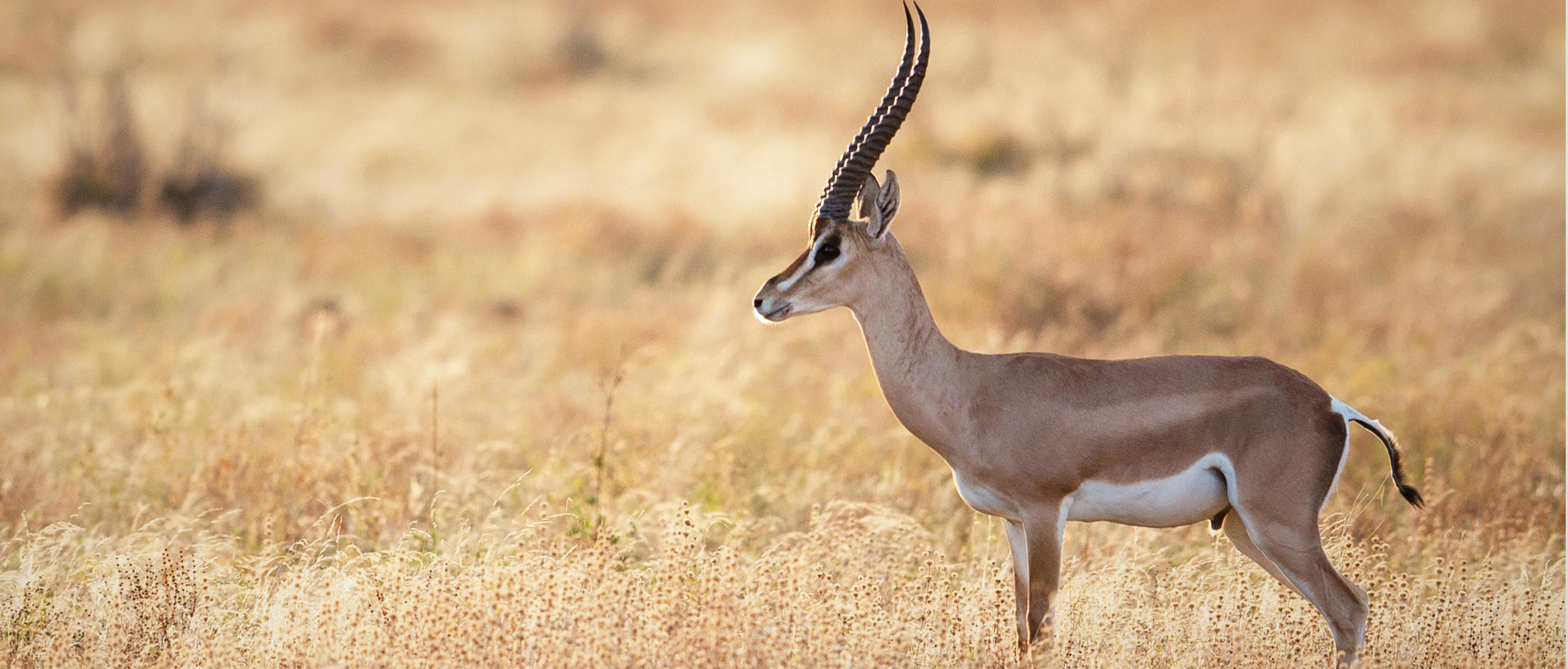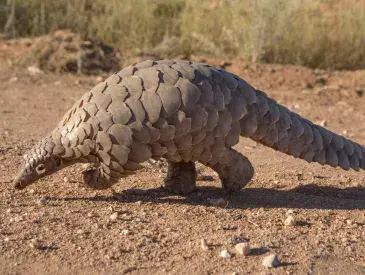What is a Grant’s gazelle?
There are three subspecies of Grant’s gazelle. This species of gazelle resemble Thomson's gazelles but are noticeably larger and easily distinguished by the broad white patch on the rump that extends upward onto the back. The white patch on the Thomson's gazelle stops at the tail. Some varieties of Grant's have a black stripe on each side of the body like the Thomson's, but all have a black stripe that runs down the thigh. In others, the stripe is very light or absent. Their lyre-shaped horns are stout at the base, clearly ringed and measuring 50 to 80 centimeters long (20 to 31 inches). Females have black skin surrounding the teats with white hair on the udder. This probably helps the young recognize the source of milk. When a fawn is older and moving about with its mother, the dark stripe on the white background may serve as a beacon for it to follow.
Nanger granti
45 to 65 kilograms (100 to 145 pounds)
140 to 166 centimeters in length (4.5 to 5.5 feet)
Average 12 years
Open grass plains, montane grasslands, subdesert, lowland thornbush, and savanna woodland
Herbivorous
7 months
Humans, all major predators
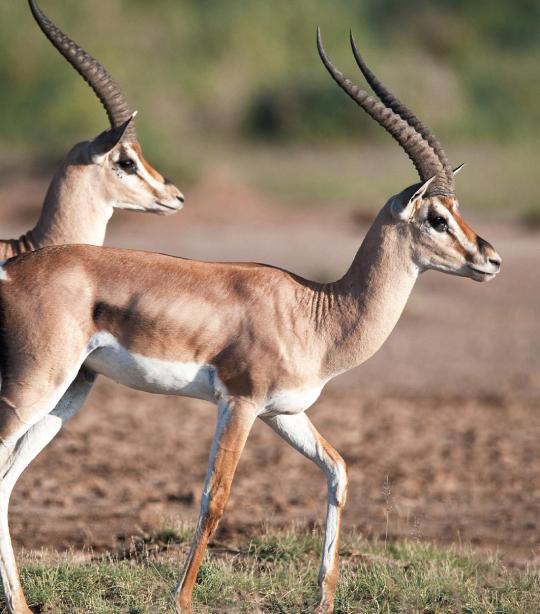
Challenges
Humans are encroaching on the Grant’s gazelle’s habitats.
Human settlement, ranching, agriculture expansion, and fencing of land results in habitat loss or fragmentation of the Grant’s living species. While this gazelle remains widespread in its range across East Africa, only about 25 percent of the population is considered stable or to be increasing. If this downward trend of other populations continues, then the IUCN states it’s only a matter of time before uplisting this species to a near threatened status.
Humans are hunting the Grant’s gazelle.
These gazelles are conspicuous and easy to kill, and it is hunted for its highly valued meat and hides.
Solutions
Our solutions to protecting the Grant’s gazelle:
African Wildlife Foundation works with governments and villages to designate wildlife corridors—large swaths of land Grant’s gazelles, and other wildlife, use to roam freely and safely from one park, or country, to another. Corridors link protected areas and allow wildlife to follow rains or travel to their calving grounds.
AWF financed The Linking Livestock Markets to Conservation initiative in Kenya. With this project, communities have improved their livelihoods through a partnership with Ol Pejeta Conservancy, which links pastoralists to premium livestock markets and provides high prices to those who adhere to conservation criteria, thereby reducing overstocking and rangeland degradation for wildlife while simultaneously increasing revenue for pastoralists.
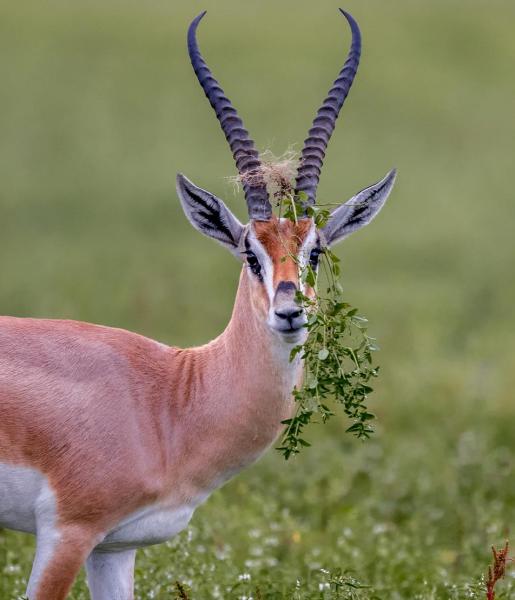
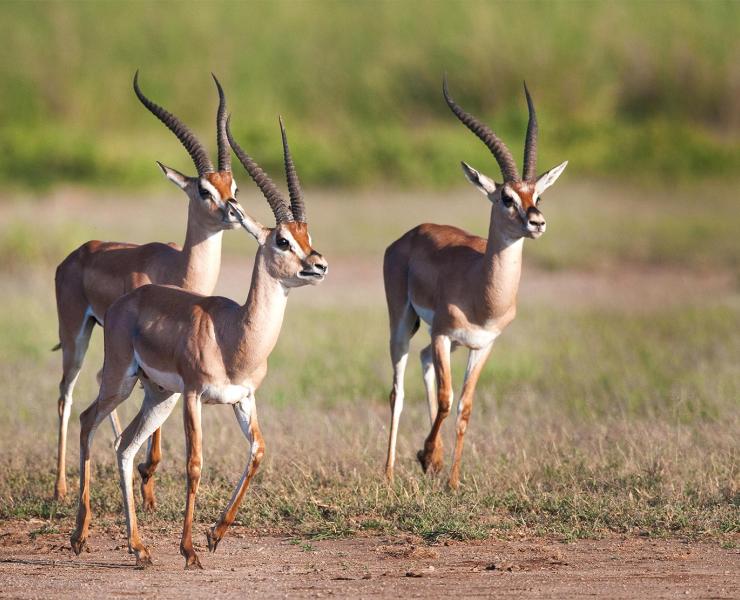
Behaviors
This gazelle tends to be less confrontational as it gets older.
Grant’s gazelles live in standard territorial, male-led herds. In more closed habitats, the herds tend to be smaller and more sexually segregated. Male gazelles have developed several ritualized postures to determine dominance. Younger males will fight, but as they grow older, the ritualized displays often take the place of fights. If neither combatant is intimidated, then they may confront one another and clash horns trying to throw the other off-balance.
Mothers carefully guard their fawns.
Breeding is seasonal but not firmly fixed. Gestation is approximately seven months, and the young are born in areas that provide some cover. Once the fawn can stand up and has been suckled, it seeks a suitable hiding place. The mother watches carefully and memorizes the position before moving away to graze. She returns to the fawn three to four times during the day to suckle it and clean the area. The laying-out period is quite long — two weeks or more. The fawn eats its first solid food at about one month but is nursed for six months. Grant's become sexually mature at about 18 months. By that time the young males will have joined an all-male bachelor herd, but it will be some time before they become territory holders, if at all. Males from the bachelor herds challenge the territorial males but only the strongest win territories, which they mark with combined deposits of dung and urine.
Diet
The Grant’s gazelle tends to vary its diet according to season.
They are primarily browsers, rather than grazers, and a large part of their diet consists of leaves and stems; although, they will eat herbs, foliage, short grasses, and shoots as well. They are not dependent on water and therefore migrate in the opposite direction of other migratory species such as the wildebeest. With the ability to obtain the moisture needed from the food they avoid competition and can survive on vegetation found in semi-desert environments. They have large salivary glands, which is possibly an adaptation for secreting fluid to cope with a relatively dry diet.
Habitats
Where do Grant’s gazelles live?
Like most gazelles, they are a migratory species but are especially fond of open grass plains, and although they frequent bushy savannas, they avoid areas of high grass. They are widespread throughout their range in East Africa — from southern Sudan and Ethiopia to Central Tanzania and from the Kenya/Somali coast to Lake Victoria.
